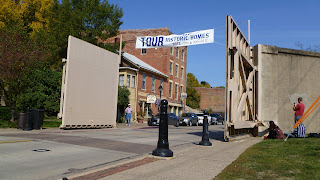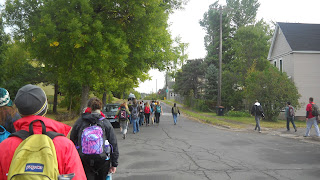Final Full Day On Savanna North Trip
The day starts with a wake up bright and early at the crack of dawn or maybe it was seven. We load up the vans at eight and depart on the two and a half mile trip to downtown Galena. We start our tour of Galena in Grant Park and slowly make our way over the Galena River, originally named the Fever River. We take minor breaks to discuss the difference between Universal Design and the Americans with Disabilities Acts. The class picks up some images of design gone wrong for our digital graphics library.
After a lecture given by Michael and Deb, the students know more about the old town. We learn the quaint little town wasn't always so picturesque, like Chicago the small town once was destroyed by fire. The now retail oriented town was once known for it's mining and agriculture and was at the height of it's population in 1883. Although the small city lost people as time passed on the town didn't reach it's highest prosperity until the 1940s. The Galena River has always been and important source for the city, but has never truly been maintained. The city first started to dredge the river in 1839, two years after it survived it's biggest flood. The river is nearly a third of the size it originally was and in 1951 the city installed massive floodgates that will protect most of main street incase of major flooding.
The end of the lecture brings a Scavenger Hunt of sorts. The students were divided into pairs and set off to collect A section cut, a slope calculation, a sketch of something that represented the agricultural and mining past of the river, a quick study of the floodgates, a materiality study, and a quick sketch of a stone building with a date engraved.
 |
| Sketches from our scavenger hunt |
After lunch we meet for our last project of the trip. We are divided into teams and given the assignment of redesigning the entire streetscape of Galena. The project is to be started in Galena and we will be following through with more specifics back in Ames. The criteria for the project is to make a threshold that references the river. We are to make a master plan of our design with two section cuts, a design program and a perspective drawing. The trip started off with a big project but ended with a bigger one. Yet we most definitely were up for the task. Some students lowered the existing street, others made new bridges to cross the river, and one group even redirected the traffic of Main street.
The sketches above are from our initial site response and evaluation. We then spent much of the evening working away in the hotel to complete the project design and layout. Next stop....Ames! But not without a stop in Dubuque, specifically Eagle Point Park designed by Alfred Calwell.

















































